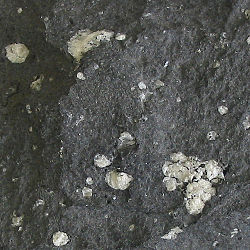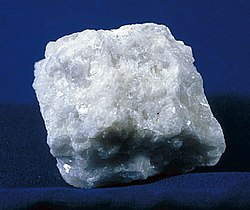Igneous rocks

- Adakite – Volcanic rock type
- Agpaitic rock – Peralkaline igneous rock
- Andesite – Type of volcanic rock
- Alkali feldspar granite – Type of igneous rock rich in alkali feldspar
- Ankaramite – Type of volcanic rock - Igneous rock belonging to basalt family
- Anorthosite – Mafic intrusive igneous rock composed predominantly of plagioclase
- Aplite – Fine-grained intrusive igneous rock type similar to granite
- Basalt – Magnesium- and iron-rich extrusive igneous rock
- Basaltic andesite – Volcanic rock that is intermediate in composition between basalt and andesite
- Basaltic trachyandesite – Naming system for volcanic rocks
- Mugearite – Volcanic rock type
- Shoshonite – Potassium-rich variety of basaltic trachyandesite
- Basanite – Type of volcanic rock
- Blairmorite – Rare porphyritic volcanic rock
- Boninite – Ultramafic extrusive rock high in both magnesium and silica
- Carbonatite – Igneous rock with more than 50% carbonate minerals
- Charnockite – Type of granite containing orthopyroxene
- Enderbite – Igneous rock of the charnockite series
- Dacite – Volcanic rock intermediate in composition between andesite and rhyolite
- Diabase , also known as dolerite – Type of igneous rock
- Diorite – Igneous rock type
- Napoleonite , also known as corsite – Variety of diorite with orbicular structure
- Dunite – Ultramafic and ultrabasic rock from Earth's mantle which is made of the mineral olivine
- Essexite – Igneous rock type
- Foidolite – Igneous rock rich in feldspathoid minerals
- Gabbro – Coarse-grained mafic intrusive rock
- Granite – Type of igneous rock
- Granodiorite – Type of coarse grained intrusive igneous rock
- Granophyre – Type of subvolcanic rock
- Harzburgite – Ultramafic mantle rock
- Hornblendite – Plutonic rock consisting mainly of the amphibole hornblende
- Hyaloclastite – Volcaniclastic accumulation or breccia
- Icelandite – Igneous rock type
- Ignimbrite – Type of volcanic rock
- Ijolite – Igneous rock consisting essentially of nepheline and augite
- Kimberlite – Igneous rock which sometimes contains diamonds
- Komatiite – Magnesium-rich igneous rock
- Lamproite – Mantle rock expulsed to the surface in volcanic pipes
- Lamprophyre – Type of ultrapotassic igneous rock – An ultramafic, ultrapotassic intrusive rock dominated by mafic phenocrysts in a feldspar groundmass
- Latite – Type of volcanic rock – A silica-undersaturated form of andesite
- Leucitite
- Lherzolite – An ultramafic rock, essentially a peridotite
- Monzodiorite An intrusive igneous rock intermediate in composition between diorite and monzonite
- Monzogabbro – Type of intrusive igneous rock
- Monzogranite – Biotite granite rocks that are considered to be the final fractionation product of magma – A silica-undersaturated granite with <5% normative quartz
- Monzonite – Igneous intrusive rock with low quartz and equal plagioclase and alkali feldspar – a plutonic rock with <5% normative quartz
- Nepheline-bearing diorite – Form of intrusive igneous rock
- Nepheline syenite – Holocrystalline plutonic rock – A silica-undersaturated plutonic rock of nepheline and alkali feldspar
- Nephelinite – Igneous rock made up almost entirely of nepheline and clinopyroxene – A silica-undersaturated plutonic rock with >90% nepheline
- Norite – Mafic intrusive igneous rock – A hypersthene-bearing gabbro
- Obsidian – Naturally occurring volcanic glass
- Pegmatite – Igneous rock with very large interlocked crystals
- Peridotite – Coarse-grained ultramafic igneous rock type
- Phonolite – Uncommon extrusive rock – A silica-undersaturated volcanic rock; essentially similar to nepheline syenite
- Phonotephrite – A volcanic rock with a composition between phonolite and tephrite
- Picrite – Variety of high-magnesium basalt that is very rich in the mineral olivine – An olivine-bearing basalt
- Porphyry – Textural form of igneous rock with large grained crystals in a fine matrix
- Pumice – Extremely vesicular volcanic rock, typically light-colored
- Pyroxenite – Igneous rock - a coarse grained plutonic rock composed of >90% pyroxene
- Quartz diorite – Igneous, plutonic rock – A diorite with >5% modal quartz
- Quartz monzonite – Type of igneous rock – An intermediate plutonic rock, essentially a monzonite with 5–10% modal quartz
- Quartzolite – Extremely rare igneous rock made mostly of quartz – An intrusive rock composed mostly of quartz
- Rhyodacite – Volcanic rock rich in silica and low in alkali metal oxides – A felsic volcanic rock which is intermediate between a rhyolite and a dacite
- Rhyolite – Igneous, volcanic rock, of felsic (silica-rich) composition
- Comendite – Hard, peralkaline igneous rock, a type of light blue grey rhyolite
- Pantellerite – Peralkaline rhyolite type of volcanic rock
- Scoria – Dark vesicular volcanic rock
- Shonkinite – Intrusive igneous rock – a plutonic rock
- Sovite – Igneous rock – A coarse-grained carbonatite rock
- Syenite – Intrusive igneous rock – A plutonic rock dominated by orthoclase feldspar; a type of granitoid
- Syenogranite – Intrusive igneous rock of the granite family
- Tachylyte – Form of basaltic volcanic glass – Essentially a basaltic glass
- Tephriphonolite – Type of igneous rock – A volcanic rock with a composition between phonotephrite and phonolite
- Tephrite – Igneous, volcanic rock – A silica-undersaturated volcanic rock
- Tonalite – Igneous rock – A plagioclase-dominant granitoid
- Trachyandesite – Extrusive igneous rock – An alkaline intermediate volcanic rock
- Benmoreite – Volcanic rock type - sodic trachyandesite
- Trachybasalt – Volcanic rock – A volcanic rock with a composition between basalt and trachyte
- Trachyte – Extrusive igneous rock – A silica-undersaturated volcanic rock; essentially a feldspathoid-bearing rhyolite
- Troctolite – Igneous rock – A plutonic ultramafic rock containing olivine, pyroxene and plagioclase
- Trondhjemite – Light-colored intrusive igneous rock – A form of tonalite where plagioclase-group feldspar is oligoclase
- Tuff – Rock consolidated from volcanic ash
- Vitrophyre – Glassy volcanic rock - Glassy igneous rock with phenocrysts
- Websterite – Ultramafic and ultrabasic rock – A type of pyroxenite, composed of clinopyroxene and orthopyroxene
- Wehrlite – Ultramafic rock - An ultramafic plutonic or cumulate rock, a type of peridotite, composed of olivine and clinopyroxene









